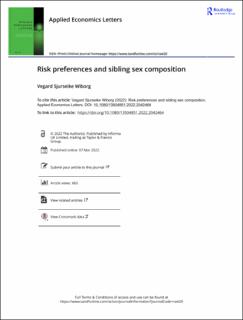| dc.contributor.author | Wiborg, Vegard Sjurseike | |
| dc.date.accessioned | 2022-09-09T11:23:46Z | |
| dc.date.available | 2022-09-09T11:23:46Z | |
| dc.date.created | 2022-04-03T19:56:17Z | |
| dc.date.issued | 2022 | |
| dc.identifier.citation | Applied Economics Letters. 2022, . | |
| dc.identifier.issn | 1350-4851 | |
| dc.identifier.uri | https://hdl.handle.net/11250/3016885 | |
| dc.description.abstract | This article presents evidence on the malleability of preferences over monetary risk of men and women in the context of the family. I focus on sibling sex composition by estimating the causal effect of having a younger brother compared to a sister on the risk attitudes of the first-born child. Results show that women with a younger brother are significantly less risk averse than women with younger sisters. The effect wears off as the age difference increases. The sex of the second-born has a similar but smaller effect on men’s preferences, however, the effect is not statistically significant. The findings provide new causal evidence on how risk preferences are shaped by social environmental factors. | |
| dc.language.iso | eng | |
| dc.title | Risk preferences and sibling sex composition | |
| dc.title.alternative | Risk preferences and sibling sex composition | |
| dc.type | Peer reviewed | |
| dc.type | Journal article | |
| dc.description.version | publishedVersion | |
| dc.source.pagenumber | 0 | |
| dc.source.journal | Applied Economics Letters | |
| dc.identifier.doi | 10.1080/13504851.2022.2042464 | |
| dc.identifier.cristin | 2014937 | |
| cristin.ispublished | true | |
| cristin.fulltext | original | |
| cristin.qualitycode | 1 | |
